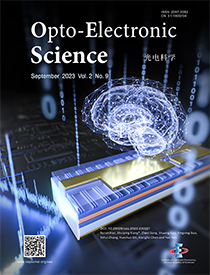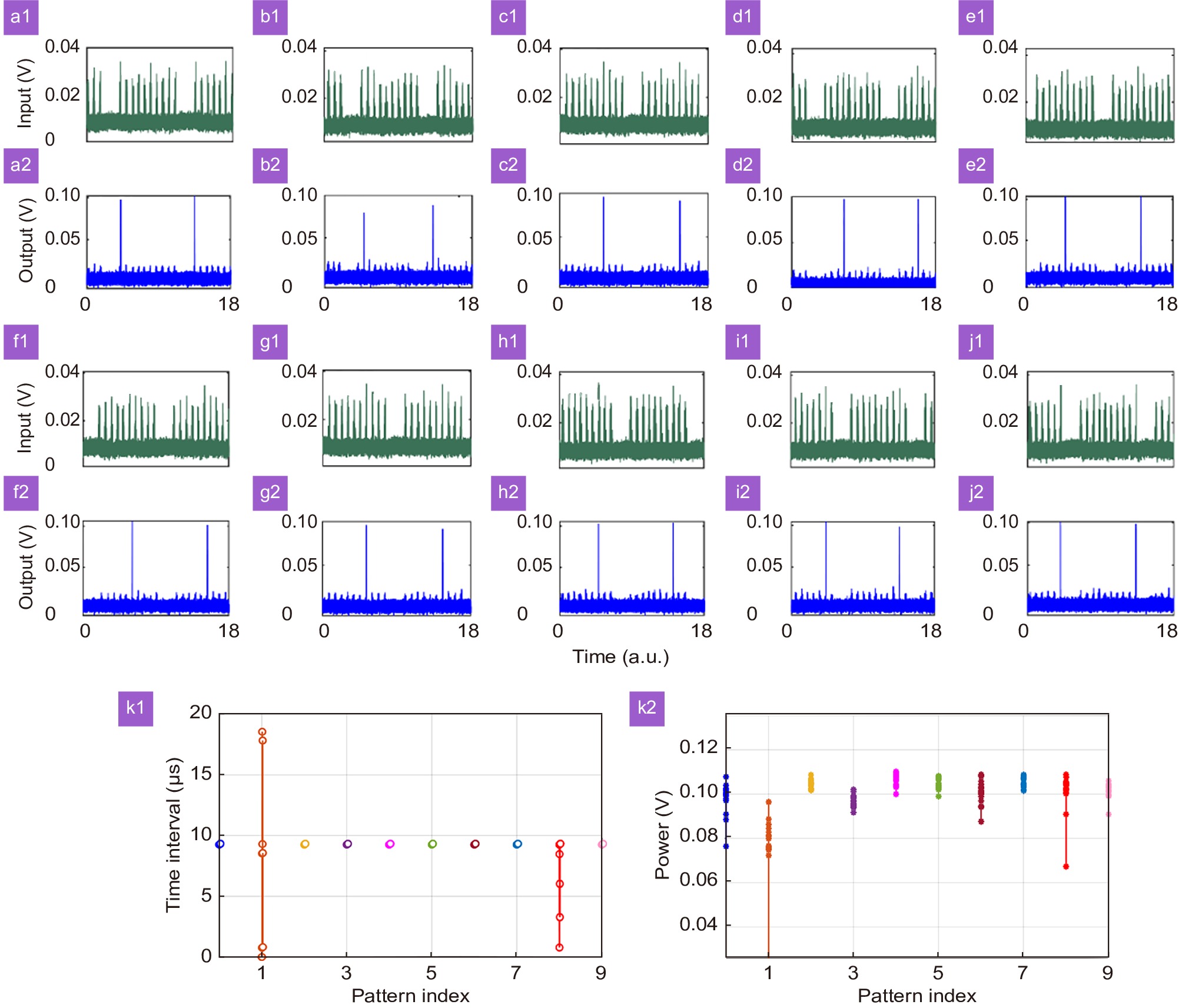| Citation: | Han YN, Xiang SY, Song ZW, Gao S, Guo XX et al. Pattern recognition in multi-synaptic photonic spiking neural networks based on a DFB-SA chip. Opto-Electron Sci 2, 230021 (2023). doi: 10.29026/oes.2023.230021 |
Pattern recognition in multi-synaptic photonic spiking neural networks based on a DFB-SA chip
-
Abstract
Spiking neural networks (SNNs) utilize brain-like spatiotemporal spike encoding for simulating brain functions. Photonic SNN offers an ultrahigh speed and power efficiency platform for implementing high-performance neuromorphic computing. Here, we proposed a multi-synaptic photonic SNN, combining the modified remote supervised learning with delay-weight co-training to achieve pattern classification. The impact of multi-synaptic connections and the robustness of the network were investigated through numerical simulations. In addition, the collaborative computing of algorithm and hardware was demonstrated based on a fabricated integrated distributed feedback laser with a saturable absorber (DFB-SA), where 10 different noisy digital patterns were successfully classified. A functional photonic SNN that far exceeds the scale limit of hardware integration was achieved based on time-division multiplexing, demonstrating the capability of hardware-algorithm co-computation. -

-
References
[1] Moradi S, Qiao N, Stefanini F, Indiveri G. A scalable multicore architecture with heterogeneous memory structures for dynamic neuromorphic asynchronous processors (DYNAPs). IEEE Trans Biomed Circuits Syst 12, 106–122 (2018). doi: 10.1109/TBCAS.2017.2759700 [2] Rathi N, Chakraborty I, Kosta A, Sengupta A, Ankit A et al. Exploring neuromorphic computing based on spiking neural networks: algorithms to hardware. ACM Comput Surv 55, 243 (2023). [3] Roy K, Jaiswal A, Panda P. Towards spike-based machine intelligence with neuromorphic computing. Nature 575, 607–617 (2019). doi: 10.1038/s41586-019-1677-2 [4] Ponulak F, Kasinski A. Introduction to spiking neural networks: information processing, learning and applications. Acta Neurobiol Exp 71, 409–433 (2011). [5] Taherkhani A, Belatreche A, Li YH, Cosma G, Maguire LP et al. A review of learning in biologically plausible spiking neural networks. Neural Netw 122, 253–272 (2020). doi: 10.1016/j.neunet.2019.09.036 [6] Nandakumar SR, Boybat I, Le Gallo M, Eleftheriou E, Sebastian A et al. Experimental demonstration of supervised learning in spiking neural networks with phase-change memory synapses. Sci Rep 10, 8080 (2020). doi: 10.1038/s41598-020-64878-5 [7] Sengupta A, Banerjee A, Roy K. Hybrid spintronic-CMOS spiking neural network with on-chip learning: devices, circuits, and systems. Phys Rev Appl 6, 064003 (2016). doi: 10.1103/PhysRevApplied.6.064003 [8] Sengupta A, Panda P, Wijesinghe P, Kim Y, Roy K. Magnetic tunnel junction mimics stochastic cortical spiking neurons. Sci Rep 6, 30039 (2016). doi: 10.1038/srep30039 [9] Jo SH, Chang T, Ebong I, Bhadviya BB, Mazumder P et al. Nanoscale memristor device as synapse in neuromorphic systems. Nano Lett 10, 1297–1301 (2010). doi: 10.1021/nl904092h [10] Boybat I, Le Gallo M, Nandakumar SR, Moraitis T, Parnell T et al. Neuromorphic computing with multi-memristive synapses. Nat Commun 9, 2514 (2018). doi: 10.1038/s41467-018-04933-y [11] Cassidy AS, Merolla P, Arthur JV, Esser SK, Jackson B et al. Cognitive computing building block: a versatile and efficient digital neuron model for neurosynaptic cores. In Proceedings of 2013 International Joint Conference on Neural Networks 1–10 (IEEE, 2013); http://doi.org/10.1109/IJCNN.2013.6707077. [12] Kim H, Hwang S, Park J, Yun S, Lee JH et al. Spiking neural network using synaptic transistors and neuron circuits for pattern recognition with noisy images. IEEE Electron Device Lett 39, 630–633 (2018). doi: 10.1109/LED.2018.2809661 [13] Erdener Ö, Ozoguz S. A new neuron and synapse model suitable for low power VLSI implementation. Analog Integr Circ Sig Process 89, 749–770 (2016). doi: 10.1007/s10470-016-0773-6 [14] Schuman CD, Potok TE, Patton RM, Birdwell JD, Dean ME et al. A survey of neuromorphic computing and neural networks in hardware. arXiv: 1705.06963, 2017.https://doi.org/10.48550/arXiv.1705.06963 [15] Meng XY, Zhang GJ, Shi NN, Li GY, Azaña J et al. Compact optical convolution processing unit based on multimode interference. Nat Commun 14, 3000 (2023). doi: 10.1038/s41467-023-38786-x [16] Ohno S, Tang R, Toprasertpong K, Takagi S, Takenaka M. Si microring resonator crossbar array for on-chip inference and training of the optical neural network. ACS Photonics 9, 2614–2622 (2022). doi: 10.1021/acsphotonics.1c01777 [17] Jiao SM, Liu JW, Zhang LW, Yu FH, Zuo GM et al. All-optical logic gate computing for high-speed parallel information processing. Opto-Electron Sci 1, 220010 (2022). doi: 10.29026/oes.2022.220010 [18] Huang CR, Sorger VJ, Miscuglio M, Al-Qadasi M, Mukherjee A et al. Prospects and applications of photonic neural networks. Adv Phys:X 7, 1981155 (2022). [19] Gu JQ, Feng CH, Zhu HQ, Chen RT, Pan DZ. Light in AI: toward efficient neurocomputing with optical neural networks—a tutorial. IEEE Trans Circuits Syst II:Express Briefs 69, 2581–2585 (2022). [20] Zhao AK, Jiang N, Peng JF, Liu SQ, Zhang YQ et al. Parallel generation of low-correlation wideband complex chaotic signals using CW laser and external-cavity laser with self-phase-modulated injection. Opto-Electron Adv 5, 200026 (2022). doi: 10.29026/oea.2022.200026 [21] Li CH, Du W, Huang YX, Zou JH, Luo LZ et al. Photonic synapses with ultralow energy consumption for artificial visual perception and brain storage. Opto-Electron Adv 5, 210069 (2022). doi: 10.29026/oea.2022.210069 [22] Xiang SY, Han YN, Song ZW, Guo XX, Zhang YH et al. A review: photonics devices, architectures, and algorithms for optical neural computing. J Semicond 42, 023105 (2021). doi: 10.1088/1674-4926/42/2/023105 [23] Coomans W, Gelens L, Beri S, Danckaert J, Van der Sande G. Solitary and coupled semiconductor ring lasers as optical spiking neurons. Phys Rev E 84, 036209 (2011). doi: 10.1103/PhysRevE.84.036209 [24] Scirè A, Mulet J, Mirasso CR, Miguel MS. Intensity and polarization self-pulsations in vertical-cavity surface-emitting lasers. Opt Lett 27, 391–393 (2002). doi: 10.1364/OL.27.000391 [25] Xiang SY, Zhang H, Guo XX, Li JF, Wen AJ et al. Cascadable neuron-like spiking dynamics in coupled VCSELs subject to orthogonally polarized optical pulse injection. IEEE J Sel Top Quantum Electron 23, 1700207 (2017). [26] Robertson J, Hejda M, Zhang YH, Bueno J, Xiang SY et al. Neuromorphic object edge detection with artifical photonic spiking VCSEL-neurons. In Proceedings of 2020 IEEE Photonics Conference 1–2 (IEEE, 2020);http://doi.org/10.1109/IPC47351.2020.9252334. [27] Chen ZJ, Sludds A, Davis R, Christen I, Ateshian L et al. Coherent VCSEL network computing. In Proceedings of the 27th OptoElectronics and Communications Conference (OECC) and 2022 International Conference on Photonics in Switching and Computing (PSC) 1–3 (IEEE, 2022);http://doi.org/10.23919/OECC/PSC53152.2022.9849860. [28] Ma BW, Zou WW. Demonstration of a distributed feedback laser diode working as a graded-potential-signaling photonic neuron and its application to neuromorphic information processing. Sci. China Inf. Sci 63, 160408 (2020). doi: 10.1007/s11432-020-2887-6 [29] Shi YC, Xiang SY, Guo XX, Zhang YH, Wang HJ et al. Photonic integrated spiking neuron chip based on a self-pulsating DFB laser with a saturable absorber. Photonics Res 11, 1382–1389 (2023). doi: 10.1364/PRJ.485941 [30] Xiang SY, Shi YC, Zhang YH, Guo XX, Zheng L et al. Photonic integrated neuro-synaptic core for convolutional spiking neural network. arXiv: 2306.02724, 2023. https://doi.org/10.48550/arXiv.2306.02724 [31] Xiang SY, Shi YC, Guo XX, Zhang YH, Wang HJ. et al. Hardware-algorithm collaborative computing with photonic spiking neuron chip based on an integrated Fabry–Perot laser with a saturable absorber. Optica 10, 162–171 (2023). doi: 10.1364/OPTICA.468347 [32] Selmi F, Braive R, Beaudoin G, Sagnes I, Kuszelewicz R et al. Relative refractory period in an excitable semiconductor laser. Phys Rev Lett 112, 183902 (2014). doi: 10.1103/PhysRevLett.112.183902 [33] Feldmann J, Youngblood N, Wright CD, Bhaskaran H, Pernice WHP. All-optical spiking neurosynaptic networks with self-learning capabilities. Nature 569, 208–214 (2019). doi: 10.1038/s41586-019-1157-8 [34] Fauth MJ, Wörgötter F, Tetzlaff C. Collective information storage in multiple synapses enables fast learning and slow forgetting. BMC Neurosci 16, O15 (2015). doi: 10.1186/1471-2202-16-S1-O15 [35] Federmeier KD, Kleim JA, Greenough WT. Learning-induced multiple synapse formation in rat cerebellar cortex. Neurosci Lett 332, 180–184 (2002). doi: 10.1016/S0304-3940(02)00759-0 [36] Golding NL, Staff NP, Spruston N. Dendritic spikes as a mechanism for cooperative long-term potentiation. Nature 418, 326–331 (2002). doi: 10.1038/nature00854 [37] Hiratani N, Fukai T. Redundancy in synaptic connections enables neurons to learn optimally. Proc Natl Acad Sci USA 115, E6871–E6879 (2018). doi: 10.1073/iti2718115 [38] Ponulak F, Kasiński A. Supervised learning in spiking neural networks with ReSuMe: sequence learning, classification, and spike shifting. Neural Comput 22, 467–510 (2010). doi: 10.1162/neco.2009.11-08-901 [39] Xiang SY, Ren ZX, Song ZW, Zhang YH, Guo XX et al. Computing primitive of fully VCSEL-based all-optical spiking neural network for supervised learning and pattern classification. IEEE Trans Neural Netw Learn Syst 32, 2494–2505 (2021). doi: 10.1109/TNNLS.2020.3006263 [40] Gütig R, Sompolinsky H. The tempotron: a neuron that learns spike timing-based decisions. Nat Neurosci 9, 420–428 (2006). doi: 10.1038/nn1643 [41] Taherkhani A, Belatreche A, Li YH, Maguire LP. DL-ReSuMe: a delay learning-based remote supervised method for spiking neurons. IEEE Trans Neural Netw Learn Syst 26, 3137–3149 (2015). doi: 10.1109/TNNLS.2015.2404938 [42] Han YN, Xiang SY, Ren ZX, Fu CT, Wen AJ et al. Delay-weight plasticity-based supervised learning in optical spiking neural networks. Photonics Res 9, B119–B127 (2021). doi: 10.1364/PRJ.413742 [43] Xiang SY, Gong JK, Zhang YH, Guo XX, Han YN et al. Numerical implementation of wavelength-dependent photonic spike timing dependent plasticity based on VCSOA. IEEE J Quantum Electron 54, 8100107 (2018). -
Access History

Article Metrics
-
Figure 1.
(a) The geometry of multi-synaptic connections. (b) The experimental setup. The optical path is denoted by yellow, and the electrical path is black. The GDS file and chip micrograph of the DFB-SA neuron chip. (c1–c3) The optical spectrum of free-running DFB-SA, marked with different injection wavelengths. (d1–d3) The optical spectrum of DFB-SA with external optical injection corresponding to (c1–c3). (e1–e3) and (f1–f3) The input pattern and the corresponding output.
-
Figure 2.
The basic structure for supervised learning of photonic SNNs with temporal coding.
-
Figure 3.
(a) The process of digit pattern recognition based on a multi-synaptic photonic spiking neural network. (b) The output classification. (c) The basic principle for temporal coding SNN. (d) The STDP rule. (e) The mean distance of 4 different training methods with different Nsyn.
-
Figure 4.
The output spike timing of all 10 output neurons (the row) at the input of all 10 patterns (the column) when Nsyn=3.
-
Figure 5.
(a) The converged Distance with 1, 2, and 3 synapses, respectively. (b1–b2) Normalized weights for each of the two sets of synapses after convergence. (c1–c2) Normalized delays for each of the two sets of synapses after convergence. (d1) The converged Distance in the parameter space of weight mismatch and delay mismatch and (d2) projection of the contour with Distance=1.
-
Figure 6.
(a1–j1) The input spike patterns for all the 10 output neurons. (a2–j2) The correlated outputs of DFB-SA. (k1) The output spike interval for all 10 output neurons of 20 experiment trials. (k2) The output spike power for all 10 output neurons of 20 experiment trials.

 E-mail Alert
E-mail Alert RSS
RSS



 DownLoad:
DownLoad:







